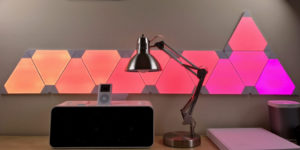When it comes to choosing smart lighting for the home, the selection falls into three camps. You can, of course, pick from plethora of color-changing LED bulbs available on the market today and install in any lamp. Alternatively, luminaires with integrated LEDs like Philips Hue Signe combine style and smarts to lift any home interior.
The Nanoleaf Canvas makes an altogether more powerful statement. A $248 starter kit (actually named “Smarter Kit”) includes nine touch-sensitive, square light panels that fix directly to the wall in a design of your choosing, individually supporting 16 million colors. Unlike Nanoleaf’s triangular first-generation panels, Canvas ships with an integrated audio sensor, allowing your lights to sync with movies, TV, music or games.
A brief hands-on with Nanoleaf Canvas at IFA 2018 colored us impressed and left us wanting more, and few months later, we finally have the opportunity for a full review. The headline? If elegant luminaires like Philips Hue Signe are akin to Debussy, Nanoleaf Canvas is most definitely disco. Glorious disco.

As a fully wall-mounted lighting solution, Nanoleaf Canvas offers a more complex installation than a mere lamp, requiring owners to take a little time to plan, design and then implement their solution. As the name suggests, Canvas is part lighting, part illuminated art installation, with the ability to dominate the décor of any room. Up to 25 light squares (available in four-pack extensions kits) can be connected to a single power supply, while a single controller supports up to 500 panels, allowing a generous palette of pixels to play with.
The compact Nanoleaf Smarter Kit arrives with eight standard light squares (5.9 inches), a control square (which lights up just like a standard square, but includes the brains of the operation), nine linkers (which act as connecting cables, but are in fact thin PCBs) and a power supply. Also in the box, you’ll find 28 sticky mounting tabs, which affix to each corner of a panel for mounting. A screw-mounting kit for Canvas is being planned, but won’t be available until the second quarter of 2019.
The tiles themselves are well constructed, and the linker strips slide neatly and securely into their connecting slots. As a bonus, the linkers also ensure your tiles are neatly lined up during installation.
Comprehensive setup instructions make installation easier
The good news is that Nanoleaf’s accompanying app (iOS/Android) does a fantastic job of guiding you through layout, connection and configuration of the light squares. A neat layout assistant provides inspiration for however many light squares you’re installing. As you lay out your Canvas, you’ll need to ensure each square is able to connect to at least one adjacent square using the linker strips. It’s a little fiddly and, at times, it may feel like you’re playing a giant version of a tile puzzle, but it’s worth taking time to get right before mounting.
Connect power and hook Canvas up to your Wi-Fi (via the app) and you’re ready to explore the possibilities of your new light installation. We found connection to be mostly simple, although it took a few tries to enable Canvas’ wireless network connection. Pairing our smartphone to the connector square (during which a code is passed between devices using NFC) was also a little clunky.
Touch-sensitive panels create a riot of fun and color
Canvas can be operated in a variety of modes. Touch-sensitive buttons on the control panel allow you to switch between rhythm mode and shuffle as well as select color scenes and change brightness settings. Using the Nanoleaf app isn’t mandatory. That makes Canvas a great choice for kids’ bedrooms, enabling them to have fun with light settings through touch.
When you tap a panel, it becomes interactive – illuminating or sending out a ripple, depending on the scene. You’ve probably already guessed that simple color games like Simon, Whack-a-Mole, and memory tests are available to launch via the app. OK, it’s no Nintendo Switch, but they offer fun family diversions on a rainy day; simply running your hand over the Canvas squares and seeing the results is a simple pleasure. Gesture controls can also be programmed, allowing scene and brightness changes through swipes on a light square.

Elsewhere, you can set hourly, daily or weekly schedules for automatic playing of scenes, gradually dim or brighten the lights for evenings and mornings, or toggle lights when you’re on vacation to deter unwanted visitors. Add useful tutorials on using features in the app, and it all adds up to one of the most accomplished smart home controller apps we’ve encountered in 2018.
Warranty information
Nanoleaf Canvas is supported by a two-year warranty covering manufacturer defects.
Pros:
- Modular
- Expandable
- Super bright
- Can control each triangle
- HomeKit compatible
Cons:
- Requires 2.4GHz network
- Connectivity problems
- Odd LED flashes
- Flickering color transitions at low brightness



















Lian - October 9, 2019 @ 12:55
I LOOOOVE these things. I drive a semi truck and it’s a little dark in the bottom bunk area, so I stuck these on the bottom of the top bunk, and boom. Let their be light. I have scenes setup for movie lighting, bedtime, it even wakes me up in the morning to a simulated sunrise with their alarm setting. I had some issues with adhesion to the bunk (it’s a fake texture leather) so I put a dab of gel superglue on the 3M strips and it was no problem. I got the 9 pack and they are plenty bright as well, however, I don’t think the 4 pack would give off enough light.
I LOOOOVE these things. I drive a semi truck and it’s a little dark in the bottom bunk area, so I stuck these on the bottom of the top bunk, and boom. Let their be light. I have scenes setup for movie lighting, bedtime, it even wakes me up in the m
Jonathan - October 12, 2019 @ 14:10
The panels are great and work fine but for something that isn’t cheap I’d expect the app to work fine with it. The app is horrible for me and most of the time doesn’t connect to the panels even though it’s been reset multiple times.
Quite annoying going to lay down in bed and the app decides to not connect so you have to get back up and manually turn it off with the button on the receiver.
The panels are great and work fine but for something that isn’t cheap I’d expect the app to work fine with it. The app is horrible for me and most of the time doesn’t connect to the panels even though it’s been reset multiple
Rick - October 14, 2019 @ 21:04
bought these to hang in my office at work. They are stunning. The controls via the app are great. Over half of my coworkers have complimented them and mentioned that they were also interested in buying a set. Unfortunately the price is cost prohibitive for most people. Hopefully the cost/price can come down a bit over time to allow more people to own these amazing lights.
bought these to hang in my office at work. They are stunning. The controls via the app are great. Over half of my coworkers have complimented them and mentioned that they were also interested in buying a set. Unfortunately the price is cost prohibiti
Cortney - October 14, 2019 @ 22:16
I would give the assembly and hooking up to your phone process 3 stars. The lights themselves I will d give 5 stars. The light looks great in any color and they get so bright! The directions on hooking them up to your phone suck but once you get that done hooking them to the wall is a piece of cake. They are super light weight as well.
I would give the assembly and hooking up to your phone process 3 stars. The lights themselves I will d give 5 stars. The light looks great in any color and they get so bright! The directions on hooking them up to your phone suck but once you get that
James - October 15, 2019 @ 18:23
Great product. Easy to setup and works great with the app. Only issue you may run into is it doesn’t work with the app when connected to a 5ghz network.